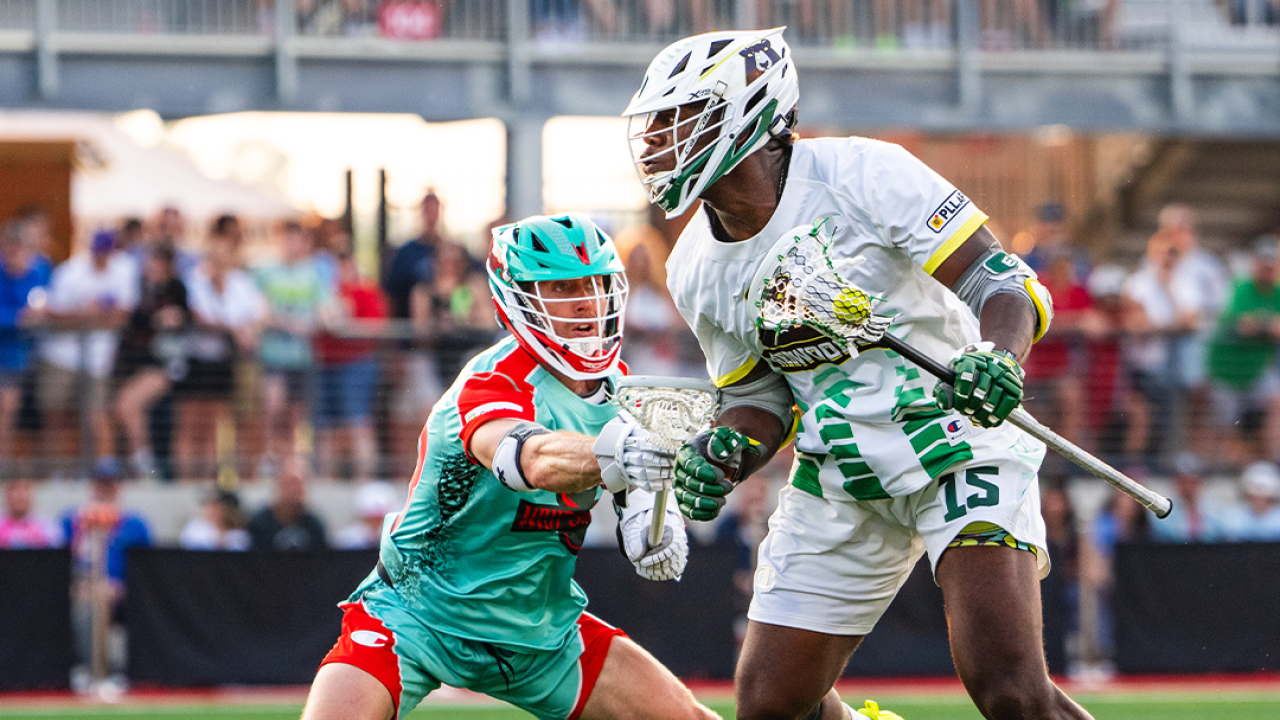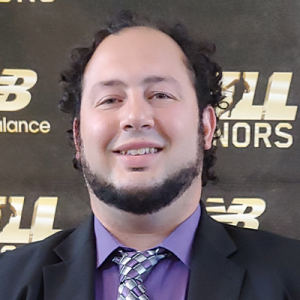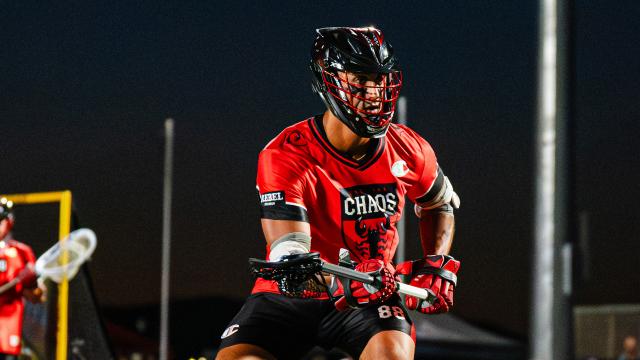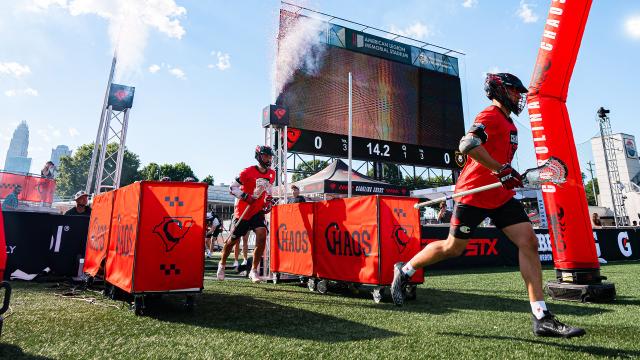
Let's Make a Deal: Why It's So Hard to Make a Trade in the PLL
On August 8, the first in-season trade of the 2023 Premier Lacrosse League season was completed when the Redwoods sent midfielder Myles Jones to the Atlas for midfielder Romar Dennis.
Redwoods head coach Nat St. Laurent said he’s always been fond of Dennis’ game. This wasn’t the first time this summer he had reached out to Atlas head coach Mike Pressler about making a deal. In fact, St. Laurent said he’d been trying to acquire Dennis in a trade going back to the first year of the league in 2019.
After years of trying and multiple conversations throughout the season, the transaction provides proof about one thing regarding player movement in the PLL. Making a trade is very difficult.
“I could tell you stories about spending 48 hours on the phone with somebody and not having it go through,” St. Laurent said.
St. Laurent is one of the more active coaches in the league when making a deal. The last trade before the Jones-Dennis swap involved the Redwoods, who sent attackman Matt Kavanagh to the Cannons in exchange for John Piatelli and Matt Rahill. Two key pieces of the current Redwoods offense, Rob Pannell and Jules Heningburg, were both acquired via trade. Jones himself was on the Redwoods’ roster thanks to another one-for-one swap when the team sent midfielder Sergio Salcido to the Chaos back in February 2020.
One of the biggest hurdles to making a deal is the lack of assets available to include in a deal, St. Laurent said.
“You only get four draft picks, so you don’t get a lot to bargain with,” he said. “In the MLL, we had seven rounds, and you’d always have the supplemental draft. I think that has a lot to play with it. Just trying to get creative when the rosters are so thin, there’s so few teams, and only having four rounds in a draft makes it tough because you don’t have a lot to package.
“I remember one year, I tried to trade a waiver spot, where our team was on the waiver wire, to add to a deal to just try and get creative. You’re not able to do it.”
Chrome head coach Tim Soudan agreed that teams don’t have too much to package together in potential deals. While he doesn’t think the league should bring back a supplemental draft, he did think it gave teams options to make deals. At the end of a Major League Lacrosse season, teams had to release players to hit a maximum roster number but would later draft players from the player pool in the supplemental draft. Soudan said some teams would trade a player for extra supplemental draft picks to bring back some of the guys they had previously released.
As for the college draft, Soudan said there are occasions in which teams are approached about individuals and the asking price often includes a first-round pick. Especially heading into the 2024 season, which many coaches view as a deep draft that could potentially feature 2023 Tewaaraton finalists Pat Kavanagh, Connor Shellenberger, CJ Kirst and Brennan O’Neill, teams are holding on to their picks seemingly more than ever before.
“The first-, second-, and third-round draft picks are really high-end guys,” he said. “If somebody wanted somebody on my team, a lot of times they’re like, ‘I don’t want to trade draft picks.’ They’re so valuable, it’s almost like a non-starter.”
The market value for draft picks, particularly first rounders, was set steep back in the 2021 offseason when the Cannons acquired Paul Rabil and the sixth pick in the 2021 Entry Draft in exchange for the Cannons’ ninth overall pick in the Entry Draft, the eighth overall pick in the 2021 College Draft and a first-round pick in the 2022 College Draft.
Sean Quirk was the head coach of the Cannons at the time. While Rabil’s stock was at the lowest of his career, coming off a 2020 season in which he scored one goal in the team’s five games. Quirk believed that dip was partially due to a culture issue. He felt a change of scenery would rejuvenate Rabil and that his leadership and experience — combined with what he felt he still had left in the tank — would help the Cannons win games in what was essentially an expansion team season.
The move helped in the short term. In nine games, Rabil scored 18 goals — including two two-point goals — and contributed six assists and earned his 10th All-Star selection and a spot on the league’s All-Pro team. The Cannons also earned a trip to the playoffs.
Rabil retired after the season. The Atlas used the second pick they acquired from the Cannons to select Chris Gray, who has been selected to the All-Star Game in both seasons of his professional career. By the time the Cannons picked again in the second round, they also missed out on 2022 Rookie of the Year Brendan Nichtern as well as players like Arden Cohen, Matt Moore and Koby Smith, who are starting players in the PLL. The Cannons won one game that season and missed the playoffs. To make matters worse, the team traded its 2023 first-round selection to the Atlas, which would have been the top pick in the draft, for the 11th and 24th overall picks in the 2022 draft, which became defensive midfielder Bubba Fairman and goalie Colin Kirst.
It was a domino effect and what Quirk said is the gamble you take when making a deal, especially one that involves draft picks.
“You never go in guns blazing saying, ‘I’m going to give you my first-round pick,’” Quirk said. “We went in with a second-round pick, a third-round pick and an early round pick in the next year’s draft. [Former Cannons head coach Ben] Rubeor kept coming back to us with the history of Paul’s playing career and that a change of scenery could be a really good thing for him. I had multiple talks with Paul while we were negotiating.
“It got to a tipping point that he was just not going to budge, to his credit. We felt strongly enough about it that we wanted to make the move, and we pulled the trigger.”
The Kirst pick the Atlas sent to the Cannons was not originally theirs. That pick was acquired in a trade with the Chaos, who acquired attackman Chris Cloutier in the deal. In a deal announced the same day, the Chaos had also traded goalie Dillon Ward to the Waterdogs for attackman Wes Berg.
When constructing a trade and shaping his roster, Chaos head coach Andy Towers said the most important thing is the locker room fit. He said he would never make a trade for a player that isn’t just as good a teammate or better than the guy they’re giving up, so it’s imperative he do his due diligence. His process starts with informal conversations with other coaches, which tend to reveal who coaches are willing to give up. Towers noted it isn’t prudent to chase a trade for a player the coach isn’t going to give up no matter what.
“You’re not just getting rid of skill set,” Towers said. “You’re getting rid of a piece of the locker room. You’ve got to make sure that in pursuit of becoming a more talented roster that you don’t damage your locker room in the process of doing that. I’m a firm believer that, in the PLL, the teams that are most connected are ultimately in the best position to win the championship, even if they are slightly less talented because every team is talented enough.”
It's a situation Soudan found himself in several times in the past.
“We try to create a culture where if you have a guy that’s not fitting in, but he’s a talented guy, that’s an easy trade,” he said. “Back in the day, people were trying to give me all sorts of stuff for Jordan Wolf. Well, Jordan Wolf is untradeable because he is the essence of what we were. Joel White was the same guy. Everybody wanted to get their hands on Joel White, but there’s no way I would trade him because you’re basically giving up your locker room that you really have to repair after doing that for draft picks or even a couple guys. When you find an elite guy in this league that is in every game and a high-end guy, people don’t want to trade him.”
While Towers appreciates the responsibility that comes with being a general manager and having control over who is brought into the team, because that locker room culture is so important, he also seeks the input of his locker room when it comes to trades.
“There are key players on our team whose opinions carry a lot of weight,” Towers said. “We make sure we go through all the appropriate channels and talk to everybody before we pull the trigger. Whether we do it or not do it, we want to make sure we have 100 percent buy-in from everyone.”
Another factor coaches consider when making trades is the playoffs. Currently, seven of the league’s eight teams make the playoffs. That final playoff spot usually isn’t determined until the last week or two of the season. In 2021, the Cannons beat the Chrome in the final game to determine who would make the playoffs. In 2022, the Chaos finished one game better than the Cannons even though both teams lost each of their final three games.
Heading into the penultimate week of the 2023 season, the Chrome had one win and were in last place in the league, but there was still a chance to make the playoffs, as the Atlas sit only one game better in the standings.
“We’re not ruled out at this point,” Soudan said. “That’s what we’re working toward. I’m not even considering what it looks like if we come in last. Obviously, there’s some great players out there [in the draft], but that’s not even a conversation we’re having yet. We know that if we get in the playoffs, we start playing better offense, we have a chance to win this whole thing. We play people tight here and there. We just need to finish our opportunities.”
St. Laurent sees the how teams approach trades when considering the playoff picture as a personal philosophy issue. For him, more teams in the playoffs gives even more of a reason to make trades earlier in the season.
“I’m kind of like, ‘Let’s figure this thing out and win now,’” he said. “There’s a pretty good chance we’re going to make the playoffs, so let’s make this move and position ourselves to work on the chemistry earlier instead of waiting until late.”
It’s with that eye toward the playoffs that St. Laurent made his latest move to bring in Dennis. At the time of the trade, the Redwoods had yet to score a two-point goal all season. Dennis has been a two-point threat his entire career, and even though he hadn’t lived up to expectations in 2023, he still was in the top 10 in the league in two-point goals. St. Laurent said he gave Dennis a big bear hug when he arrived in the locker room.
Getting a player he had tried to acquire for four years, one that was active and contributing for his team every week, wasn’t going to happen without cost, however, and for the Redwoods, that cost was Jones. St. Laurent said he loved Jones as a person and had built an incredible relationship with him, but Jones was left off the active roster two weeks in a row. He wanted to do right by Jones, and he hoped that would happen with a fresh start on a new team.
“It was starting to look like it wasn’t going to work out with our team for him. Instead of having him sit there, I was like, ‘How can I give him a chance and make our team better? How do I help the person I’m trading?’” he said. “Myles wasn’t having his best year with us, but it wasn’t too long ago he was second in the league in assists and leading midfielders in points. He needed a fresh start.
“When we traded Myles to the Atlas, I know Coach Pressler is a great man, and he’s genuine, and he thinks very highly of the players. It made me happy knowing Myles was going to a place where he was going to be happy and well received.”
Phil Shore
Phil Shore has covered lacrosse for a variety of publications. He played Division III lacrosse at Emerson College and is the current head coach at Osbourn Park High School in Virginia. His first book, Major League Life, was published in June 2020. Shore has contributed to USA Lacrosse Magazine since 2011.

Categories
Related Articles




